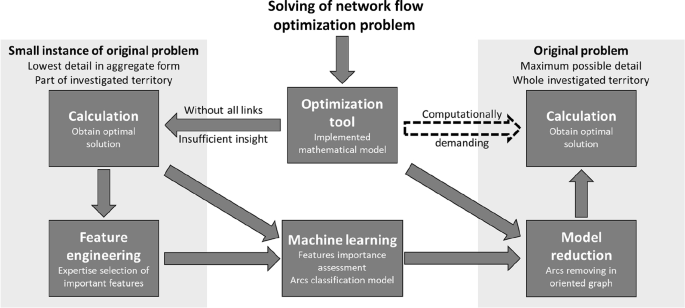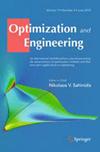使用机器学习的网络流问题启发式约简
IF 1.7
3区 工程技术
Q2 ENGINEERING, MULTIDISCIPLINARY
引用次数: 0
摘要
为物流优化和加工基础设施规划而开发的辅助工具大多是基于网络流问题的。这些工具的实际应用可以提供深刻的见解,并有助于确保长期可持续性。这些工具的主要限制在于,当需要非常详细地解决大规模任务时,计算需求很大。这意味着为现实问题找到最优解决方案的能力是有限的。因此,基础设施的细节通常通过数据聚合或启发式方法来减少,以找到次优解决方案。本文提出了一种机器学习分类模型,以减少精确解算法的变量数量。首先,实验设计是用来创建一组可能精确解决的小问题。该阶段使用人工数据,并利用领域知识设置合适的分布和参数。其次,分类模型估计最优解中每个弧存在的概率。在分类模型中利用了每条弧的特征,这些特征与成本和容量有关。在生成的问题子集上创建的模型,然后在其他问题上进行测试。最后,提议的框架适用于捷克共和国的废物管理问题。验证结果表明,在不影响战略决策和不显著改变目标函数的情况下,可以去除95%的弧线。简化后的问题计算时间仅为原任务的7%。本文章由计算机程序翻译,如有差异,请以英文原文为准。

Network flow problem heuristic reduction using machine learning
Abstract Most of the supporting tools developed for logistic optimization and processing infrastructure planning are based on the network flow problem. The real-world application of these instruments can provide great insight and help to ensure long-term sustainability. The main limitation of these tools lies in great computing demand when there is the necessity of solving large-scale tasks in great detail. It means that the ability to find the optimal solution for real-world problems is limited. Thus, the detail of infrastructure is often reduced by data aggregation or heuristic approaches are used to find a suboptimal solution. This paper proposes a machine learning classification model to reduce the number of variables for an exact solution algorithm. First, the design of experiments is used to create a set of smaller problems that are possible to solve exactly. Artificial data are used at this stage, while domain knowledge is used to set appropriate distribution and parameters. Second, the classification model estimates the probability of the presence of each arc in the optimal solution. Features, which are related to costs and capacity, of each arc are utilized in the classification model. Models created on a subset of generated problems are then tested on the other problems. Finally, the proposed framework is applied to the waste management problem in the Czech Republic. The results of the verification show, that it is possible to remove 95% of arcs without impact on strategic decisions and without significant change of an objective function. The computing time of the reduced problem takes only 7% of the original task.
求助全文
通过发布文献求助,成功后即可免费获取论文全文。
去求助
来源期刊

Optimization and Engineering
工程技术-工程:综合
CiteScore
4.80
自引率
14.30%
发文量
73
审稿时长
>12 weeks
期刊介绍:
Optimization and Engineering is a multidisciplinary journal; its primary goal is to promote the application of optimization methods in the general area of engineering sciences. We expect submissions to OPTE not only to make a significant optimization contribution but also to impact a specific engineering application.
Topics of Interest:
-Optimization: All methods and algorithms of mathematical optimization, including blackbox and derivative-free optimization, continuous optimization, discrete optimization, global optimization, linear and conic optimization, multiobjective optimization, PDE-constrained optimization & control, and stochastic optimization. Numerical and implementation issues, optimization software, benchmarking, and case studies.
-Engineering Sciences: Aerospace engineering, biomedical engineering, chemical & process engineering, civil, environmental, & architectural engineering, electrical engineering, financial engineering, geosciences, healthcare engineering, industrial & systems engineering, mechanical engineering & MDO, and robotics.
 求助内容:
求助内容: 应助结果提醒方式:
应助结果提醒方式:


